Adam Yamey's Blog: YAMEY, page 45
July 21, 2024
Was I an inventor of rewilding?
BETWEEN 1983 AND 1994, I owned a house in Gillingham, Kent. Number 148 Napier Road was a detached dwelling with a narrow garden that stretched 180 feet behind it. Most of this long stretch was covered with grass. After I first moved into the house, I purchased an electric lawn mower, and regularly trimmed the lawn. All went well at first. However, after a few months and several mowing sessions, I found that when I was cutting the lawn my eyes streamed, and I sneezed uncontrollably. I tried wearing a facemask when mowing, but this did not relieve the symptoms. Eventually, I decided not to bother mowing the lawn.
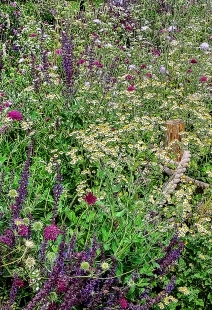
The grass grew. So did the anger of my immediate neighbours, both of whom were elderly and believed in tidy gardens. One of them said that because my lawn was so unkempt, insects were travelling from it into her garden and destroying her plants. She was so upset by this thought that she did something extremely unwise. One summer evening, I returned home after nightfall, and because the weather was pleasant, I decided to spend a few minutes in my back garden. It was dark. I sniffed, and believed that I could smell burning. I saw no flames, and retired to bed. On the next day, I met my other neighbour – a very practical old gentleman who had built his own house. He told me that during the previous day, he had had to enter my rear garden to extinguish a fire which had been started by the lady, who believed that my garden was infecting hers with pests.
Meanwhile, the grass grew longer. It reached a point where it was so tall that if someone sat down, they became hidden by it. As autumn approached, the tall grass just fell over, and seemed to disappear gradually. It returned without fail every spring, and despite not being mowed, it grew healthily. However, the neighbours were unimpressed by my lawn, the untidiest in Napier Road. I decided that I would have to do something to give the impression that my wild garden was by design, rather than simply the result of neglect. So, what I did was to use the mower to create a sinuous, narrow mowed path that ran along the length of the lawn – I created what might be described as a landscaped lawn. I am not sure that this impressed my neighbours, but I felt that I had ‘done my bit’.
In addition to the lawn, I planted shrubs, which I allowed to grow ‘willy nilly’. My seemingly wild garden was a haven for butterflies. As I walked along the garden, following my sinuous path, clouds of butterflies used to shoot out of the shrubs and other plants. Unwittingly, I had ‘wilded’ or ‘rewilded’ my garden, which in the 1980s and early 1990s was not something that was done. Had I invented what is now known as ‘wilding’, also known as ‘rewilding’? Probably not, but it only began to be adopted as a strategy for reducing loss of biodiversity following work done in the mid-1980s (see https://en.wikipedia.org/wiki/Rewilding). I must confess that my pioneering rewilding in Gillingham did not result from a desire to save the natural world, nor from laziness, but to save myself from symptoms of allergy.
In the late 1990s, we put the house up for sale. The garden had become such a veritable jungle that our estate agent described it as being “… in a natural state.” Interestingly, the people who bought the house from me liked it because they were looking forward to taming the garden – there is no accounting for taste!
July 20, 2024
Dreamlike but almost realistic from Japan
IT IS OFTEN a pleasure to see an exhibition of works by an artist, whose existence was hitherto unknown to me. In this case, the artist is the Japanese born Minoru Nomata, who was born in 1955 and lives as well as works in Japan. The exhibition of his works, currently at White Cube in Masons Yard (near Piccadilly) until the 24th of August 2024, consists mainly of paintings (acrylic on canvas).
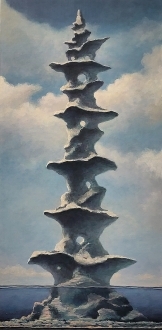
At first sight, his paintings look almost like photographs. However, after a few moments’ contemplation, they can be seen to depict subjects – often structures and aspects of nature – that are at the same time unreal and almost but not quite real. His subject matter is not quite surreal, but is an unusually dreamy interpretation of the real world. None of the paintings on display contained any signs of human presence. The gallery’s website (www.whitecube.com/gallery-exhibitions/minoru-nomata-masons-yard-2024) includes the following:
“According to the artist, ‘construction, repair and demolition’ occur simultaneously in his paintings; they confer, too, upon the simultaneity of past, present and future distinct to Nomata’s work. As he states, he sets out to create worlds that ‘are not “somewhere”, but “nowhere”, in a position that helps [him] find a place to head for’. Devoid of identifiable temporal or geographical markers as they may be, Nomata’s ambivalent landscapes speak directly to humankind’s long-standing existential concerns about what place, if any, it has in the world.”
As I viewed the pictures, which I found aesthetically pleasing, I felt they had the ‘realness’ of images that appear in dreams, yet at the same time they seemed as if they could almost be depictions of reality. In brief, I found them both attractive and intriguing, and can recommend this show to everyone.
July 19, 2024
Preaching, pits, miners, and John Wesley in rural Cornwall
METHODISM BECAME SUCCESSFUL in the county of Cornwall. Although I do not pretend to understand this branch of Christianity in any detail, I was curious to know why it had such a great appeal for the Cornish people. Apart from the great number of Methodist chapels one passes when travelling through Cornwall, there were several places associated with Methodism that sparked my interest. I will write about these after discussing why the branch of Christianity, founded by John Wesley (1703-1791), his brother Charles Wesley (1707-1788), and George Whitefield (1714-1770), was so widely accepted by the Cornish.
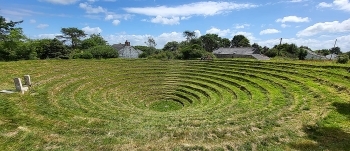
Most Methodists believe that Jesus Christ died for all of humanity, and that salvation can be achieved by everyone. This is in contrast to the Calvinist belief that God has pre-ordained the salvation of only a select group of people. Whitefield held the Calvinist position, but the Wesley brothers believed that all could be saved. Part of the appeal of Wesleyan Methodism in Cornwall was that it did not select those who could be saved from those who could not – everybody was eligible for salvation.
John Wesley first visited, and preached in, Cornwall in 1743, and then made a further 32 visits before his death in 1791 (www.cornwalls.co.uk/history/people/john_wesley.htm). During this period, Anglicanism was in decline in the county. There were several reasons for this (https://bernarddeacon.com/cornish-methodism-or-methodism-in-cornwall/the-causes-of-methodist-growth/). One of them was the rise of industrial (mainly mining) activity and its effect on the social fabric of Cornwall. Another was the fading appeal of the Anglican Church in the county. An interesting website (www.cornwallheritage.com/ertach-kernow-blogs/ertach-kernow-cornish-methodism-rise-decline/) noted that:
“The 18th century Anglican Church had greater concern for ensuring the support of wealthy and influential families rather than the poor agricultural labourers and miners that made up the vast majority of the Cornish population.”
Furthermore:
“The running of parishes were often ‘subcontracted out’ to curates and churchwardens with the clergy occupied in the major parishes and centres of religious influence. Some parishes were very large with the people spread thinly, only limited numbers living in the historic churchtowns surrounding the medieval churches. During the 18th century growth in mining, settlements gradually grew up around the sites of major mining activities leading to new villages and small, towns.”
These new settlements were often distant from the established Anglican churches, and travelling about the county was far from easy back in the 18th century. The rise in industrial activity along with the corruption of the Anglican church in Cornwall, and the economic uncertainties caused by the fluctuations in the world’s prices for what was being mined by impoverished Cornish workers with large families, left a spiritual void that preachers like John Wesley helped to fill.
But what did John Wesley and Methodism have to offer the Cornish, and to gain them as followers? To start with, Methodism as practised by Wesley did not exclude anyone from gaining salvation. A reasonable sounding explanation for the appeal of Methodism to the Cornish miners and their families was provided by the historian David Luker:
“According to Luker, for the poor Methodism did not principally legitimate ‘respectable’ or middle class values; it legitimated the morality and structures of ‘traditional’ Cornish society. It upheld and validated the cottage as a socio-economic unit in the face of the changes being wreaked by an external modernity. This role is perhaps underlined by the fact that the majority of those who joined early Methodist societies in Cornwall were women. Overall, Methodism appealed to a conservatism of the commons, seemingly justifying a way of life increasingly under pressure from economic change, just as the rituals of the Anglican church appealed to the conservatism of the propertied classes. This is why Methodism grew earliest and fastest in those districts where mining was present, in large parishes, in areas of dispersed settlement out of the reach of a socially enfeebled gentry, and in ‘unimproved’ agricultural districts.” (https://bernarddeacon.com/cornish-methodism-or-methodism-in-cornwall/the-causes-of-methodist-growth/).
Cornwall was one of the counties of England that gave Methodism its greatest acceptance.
John Wesley discovered that the Cornish enjoyed hearing him (and other preachers) in the open-air. I am not sure the reason for this. During a visit to the small Cornish town of Indian Queens, we came across a ‘preaching pit’ (see https://adam-yamey-writes.com/2024/07/03/indian-queens-in-the-heart-of-cornwall/). Because mining activity undermined the land above it, occasionally the surface would collapse causing depressions, rather like quarries, in the landscape. At Indian Queens, one such hollow was remodelled to make it into an outdoor amphitheatre with tiered rows upon which people could stand or sit whilst they listened to a preacher speaking from a stone pulpit. While we were visiting this ‘pit’, a local historian told us about other surviving pits in Cornwall, at: St Newlyn East, Whitemoor, Tregonnig Hill, and Gwennap.
The pit at Gwennap (near Redruth) is one of the most interesting places we have visited in Cornwall. It is an inverted cone with circular tiers of seating cut into its side. Grass grows on the seating and the surface surrounding the pit. Almost perfectly geometrical, it rivals some of the stone stepwells I have seen in India. The present pit was constructed in early 1807, and is still used to hold Methodist services occasionally. What exists today is a remodelling of an earlier depression in the ground which John Wesley described (in September 1766) as being:
“… a round, green hollow, gently shelving down, about fifty feet deep; but I suppose it is two hundred one way, and near three hundred the other.”
He added that he considered it to be the finest natural amphitheatre in England. People gathered within it and around its edges, and because of its shape and acoustics, Wesley’s voice could be heard by the multitudes (often thousands of people) who had come to hear him. John Wesley made 18 visits to Gwennap Pit between 1762 and 1789. He used to stand just below the outer rim of the pit, and could be heard clearly by those within the pit and those around it, even some distance away. In his diary, he noted that on the 27th of August 1780:
“It was supposed twenty thousand people were assembled at the amphitheatre at Gwennap. And yet all, I was informed, could hear me distinctly, in the fair, calm evening”
Although the size of the congregations might not have been estimated accurately, there is no doubt that they were large and because of the acoustics of the pit, they were able to hear Wesley even if they were quite a distance from him.
July 18, 2024
Kandinsky, Chicago, music, and visual arts
AT THE EXPRESSIONIST exhibition, currently showing in London’s Tate Modern until the 20th of October 2024, I was suddenly reminded of something that I did in the last three months of 1963. During those months, my father was a visiting academic in the economics department of the University of Chicago. I spent that period as a pupil in the University of Chicago’s Laboratory School. It was in that time that President John F Kennedy was assassinated.
Once a week, we had a lesson during which the teacher played us a recording of classical music – some Beethoven, for example. Each of us students were given a large sheet of white paper and some coloured crayons. While the music was playing, we could draw whatever the music inspired us to do. I cannot recall what I drew, but I do remember these lessons.
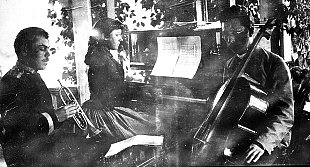
Kandinsky and his siblings
Today, the 15th of July 2024, we visited the Expressionist exhibition at the Tate Modern. In one small room, there was music by Arnold Schoenberg playing in the background. There was also a photograph (taken about 1888) of the artist Wassily Kandinsky (1866-1944) playing chamber music with his two siblings. Opposite the photograph, I saw a framed painting created by Wassily Kandinsky in 1911. It is called “Impression III (Concert)”. He painted it after hearing a concert of music by Arnold Schoenberg. This painting was his response to the music.
It was seeing this painting by Kandinsky that reminded me of our music-inspired art sessions in Chicago back in 1963.
July 17, 2024
A tower in Bath financed by sugar and slavery
I BECAME AWARE of William Thomas Beckford (1760-1844) in the late 1960s when my late friend Michael Jacobs and I were fascinated by the gothic revival that began sometime in the 18th century and continued with great vigour into the following century. Although I never read it, the ‘Gothic’ novel “Vathek” was written by Beckford, who also built the (now demolished) gothic revival style Fonthill Abbey. My interest in Beckford gradually drifted into the back of my mind and remained there until we made a visit to Bath (Somerset) in July 2024. Our hosts suggested that we visit the recently restored Beckford’s Tower, which is located on a hill just north of the Lansdown district of Bath. Kindly, they drove us there, and what we saw was interesting.
Beckford had a house in Bath’s Lansdown Crescent. It was set in extensive grounds that spread from his house to where the tower is located. The Italianate neo-classical tower was designed by the Bath-based architect Henry Goodridge (1797-1864), and completed for Beckford in 1827. It is 154 feet high and contains rooms that Beckford used as a library and living rooms. The grounds between Beckford’s house and his tower were landscaped to become Beckford’s Ride. Along the way, there is a manmade grotto, which has been recently restored.
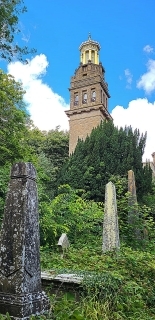
After Beckford’s death, the tower and the land associated with it were donated to Walcot Parish, which used the area to create a burial ground. In 1931, the tower and the rooms at its base were badly damaged by fire. The cemetery was closed in 1992, and the following year, the site – tower and graveyard – were purchased by the Bath Preservation Trust, who have restored it. Between 1997 and 2000, extensive repair work was carried out on the tower. Further work was undertaken between 2022 and early 2024. This rendered the tower structurally sound and safe for it to be opened to the public. Before ascending the elegant spiral (helical, actually) staircase in the tower, the visitor can view exhibits relating to the life of Beckford in the rooms at the base of the tower. Amongst these, I spotted an early edition of “Vathek”, written it the language in which it was first published: French.
The author of “Vathek” was extraordinarily wealthy. His father, Sir William Beckford (1709-1770), was born in Jamaica, and later became Lord Mayor of London (1762-1769). His wealth, and therefore that of his son, was derived from his sugar plantations he owned in Jamaica. These were worked by the hundreds of slaves he owned. Thus, the tower was financed by the labour of these unfortunate unpaid labourers. Unlike several colonial apologists I have met and heard, the website of the restored tower, and many exhibits and notices within the edifice, emphasise the way in which the author of “Vathek” was able to pay for the tower and his extravagant lifestyle. The website (https://beckfordstower.org.uk/about/history/) includes the following:
“Through marriage and ruthless ambition over four generations, the Beckford family became one of the most powerful on the island of Jamaica. Their vast fortune was built on the profits of sugar plantations, directly created through the stolen labour of thousands of enslaved Africans.
William Beckford’s father, Alderman William Beckford, used the family’s wealth to rise through British politics, and was twice Lord Mayor of London. He presented himself as a hero of liberty for British citizens, whilst people on his plantations in Jamaica were trafficked and forced into slavery, stripped of their dignity, traditions, familial ties and African names, and given the surname Beckford.”
The Lord Mayor is commemorated by a statue in London’s Guildhall.
Professor Robert Beckford (born 1965), son of black Jamaican parents, wrote (https://www.theguardian.com/commentisfree/2023/sep/19/plaque-statue-slave-trader-murder-ancestors-william-beckford-london) in connection with this statue that it ought to be labelled as follows:
“William Beckford inherited 3,000 enslaved Africans in Jamaica, whom he mercilessly exploited to accumulate great wealth in Britain. His enslaved Africans were victims of routine sexual violence, torture, bodily mutilation and mass murder. Today, we recognise slavery as a crime against humanity and an unresolved stain on the national consciousness. We display this statue not because we wish to honour Beckford, but as a reminder of how we as a nation have sanitised, obscured and neglected racial capitalism and racial terror as foundational narratives of our modern history.”
In 1835, after the British Parliament had abolished slavery, former slave owners were compensated financially as the tower’s website explained:
“In 1835 following the abolition of slavery Beckford [author of ‘Vathek’] received a compensation payment of £12,803 (nearly £1.3 million today), the ‘value’ of the lives of 1,860 enslaved people. He immediately acquired the neighbouring property at 19 Lansdown Crescent and embarked upon a further period of commissioning new furniture and interiors for his home and the Tower.”
Despite its association with slavery, the unusual Beckford’s Tower, is, like the Egyptian pyramids also built with slave labour, interesting both historically and architecturally. It has been beautifully restored. During the latest round of restorative work, care was taken to adapt the tower “… for sustainable energy use …” by installing some solar energy panels on the flat roof of the building that forms the lower part of the tower.
If you are visiting (or living in) Bath, a trip to see and enter Beckford’s Tower is well worth making. And when you are there, do not miss climbing the tower’s dramatic staircase to obtain a superb view of the city of Bath and the countryside beyond it.
July 16, 2024
Two Albanian heroes
JUST AS THE ALBANIAN Skanderbeg (Gjergj Kastrioti: c1405-1468) heroically resisted the invasion of his country by the Ottomans in the 15th century, Khwaja Safar, also an Albanian, bravely led forces opposed to the Portuguese, who were attacking his adopted country India during the 16th century. Both were forcibly converted to Islam. One remained a Muslim, and the other returned to Christianity.
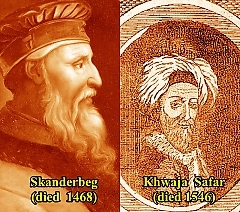
Khwaja Safar was a soldier; a merchant; the treasurer of Cairo; advisor to the Sultans of Egypt and Gujarat; and the Governor of the city of Surat. His parents were Albanian, yet he is remembered by a name which is not Albanian. You can discover why this is when reading my book about his extraordinarily fascinating life. “An Albanian in India” is available both as a paperback and a Kindle (eBook) from Amazon:
July 15, 2024
From brewery to library in a small town in Cornwall
THE TOWN OF Redruth in Cornwall was once the centre of a flourishing mining industry. Now, although it contains a few attractive buildings that remind the visitor of its heyday, it has a slightly forlorn feeling. Amongst the many places in Cornwall that attract the visitors, Redruth is not highly rated. However, it has an attraction that is well worth visiting. Located at the western edge of the old town, it is called ‘Kresen Kernow’.
Kresen Kernow is the Cornish for ‘Cornwall Centre’. Recently opened (in 2019), it houses the historical archives of Cornwall, a library, and a café. What makes it so very special is its architecture and the ‘recycling’ of a former industrial building. This used to be the on the site of the Devenish Brewery, which had been the Cornish Brewery Company Ltd until 1934. In 1991, the brewery was sold to new operators and renamed the ‘Redruth Brewery’. This closed in 2004, and the edifice fell into decay, and was damaged by fire both in 2011 and 2013.
During the early 2000s, Cornwall Council began to consider having a new archive centre and local studies library. After much deliberation, the former Redruth Brewery was chosen as the site for a new home for Cornwall’s archives. In 2015, the derelict brewhouse was purchased by the council, and after the site was cleared and decontaminated, construction commenced. The building was chosen because despite the damage it had suffered, its shell was recognised as being of great beauty. Making use of much of what was left of the original brewhouse, the architects of the Purcell Practice designed a new building. Pictures of the project before and after it was completed can be seen on their website (www.purcelluk.com/projects/kresen-ker...).
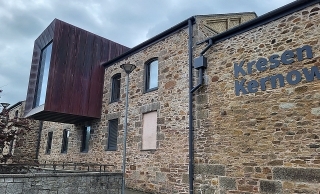
Completed in 2019, the result is a beautiful blend of modern design and the remains of the original structure. With clean lines and plenty of natural illumination, the building consists of a harmonious combination of interconnecting spaces. On the ground floor, there is a spacious reception area in which there are exhibition display cases and an area for temporary exhibitions. There is also a café. Apart from public spaces, there are several for use of the staff of the archives. The first floor has a library and rooms where people can carry out research on archival material.
Behind the refurbished building, there is a courtyard in which there are sculptures of ‘ordinary’ people. They resemble a group of people who have suddenly frozen during conversations. They were created in 2015 by two artists from Glasgow: Craig Little and Blake Whitehead.
I hope that the presence of Kresen Kernow and the gradual recognition of the beautiful 19th century and earlier buildings in the town will help elevate Redruth to the ranks of places worth visiting in Cornwall.
July 14, 2024
Discovering sculptures by Barbara Hepworth in St Ives (Cornwall)
EVERY TIME WE visit the town of St Ives in Cornwall, we come across something we have not seen before. On our most recent visit at the end of June 2024, we came across three sculptures by Barbara Hepworth (1903-1975), which were new to us. I will describe two of them in this essay, and leave the third for another time.
Hepworth migrated from Hampstead (in north London) with her second husband, the artist Ben Nicholson (1894-1982), and children, to St Ives in Cornwall at the outbreak of WW2. She lived there until the end of her life. From 1949 onwards, she lived and worked in Trewyn Studios, close to the busy heart of St Ives. This building is now a Barbara Hepworth Museum and Sculpture Garden maintained by the Tate Gallery. Visitors can see Hepworth’s studio and her garden next to it. The garden was laid out to designs created by Hepworth and her friend, the composer Priaulx Rainier (1903-1986). The garden contains works by the sculptor, which are arranged exactly as their creator had planned. We pay a visit to this lovely place every time we visit St Ives.
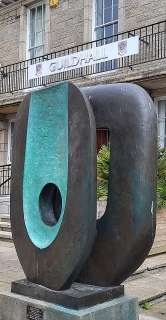
On our latest visit, we took a wrong turning, and headed down a narrow, sloping street. To our great delight we found a large outdoor sculpture by Barabara Hepworth, standing outside the front of the town’s Guildhall. Entitled “Dual Form”, this large abstract artwork made of cast bronze was created in 1965. It is part of an edition of 7 castings. The artist presented it to the town in 1968. It has blueish hues.
The other sculpture that we had not seen before is in a side chapel of St Ives’s gothic parish church of St Ia. Unlike “Dual Form”, it is figurative rather than abstract, and it is carved in shiny white stone. It depicts the Madonna and Child. Hepworth created this work following the death of her elder son, Paul Skeaping, who was an RAF air pilot. He was killed in an accident in Thailand in February 1953. The sculpture was unveiled in the church, where she found peace during her grieving, in 1954.
The two sculptures described above give a good idea of the breadth of Hepworth’s artistic talent. More evidence of her amazing creativity can be discovered in her former home, now a museum. In another piece, I will describe another sculpture and something I had not realised about Hepworth’s connection with St Ives.
July 13, 2024
A deserted dairy product factory in a small town in Somerset
WHEN TRAVELLING BETWEEN London and Cornwall, we often stop at the small town of Wincanton in Somerset. Close to the A303 trunk road, it has retained a certain ‘ye olde worlde’ charm. Once. It was a town with many coaching inns, but although many of these have closed, the buildings that housed them are still recognizable. One of the buildings on the main street houses a small museum of Wincanton. Amomgst the exhibits, there was a glass case containing old objects connected with the ‘Cow and Gate’ dairy products company. Amongst these, there were two glass feeding bottles used for feeding milk to babies.
The Cow and Gate company began life in 1882 as the ‘West Surrey Central Dairy Company’. In 1904, Dr Killick Millard developed a powdered milk, which in 1908 was marketed by the company as ‘Cow & Gate Pure English Dried Milk’. In 1929, the West Surrey Central Dairy Company Limited was renamed ‘Cow and Gate’. None of this information was available in the form of a label or information notice next to the Cow and Gate exhibit. So, I asked the lady looking after the museum why there were Cow and Gate exhibits in the museum. She explained that until (before [?]) the 1990s. Cow and Gate had a large factory in Wincanton, which had its own railway line, a branch of the now closed (in 1966) Somerset and Dorset Joint Railway.
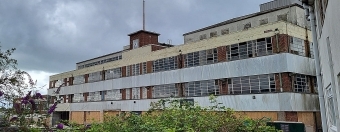
We strolled downhill to the south of the old part of the town, and came across the former Cow and Gate factory. With three storeys, a centrally located clock tower. and windows fitted with Crittall frames, it is a fine example of interwar Modernist industrial architecture. Today, many of the windowpanes are broken and the building has a deserted, neglected appearance. Boards with the name of Myakka – a design company – are attached, but there was no sign of life within the building and the yard surrounding it. We could not enter the old factory, but Myakka have posted pictures of its interior on it company website (https://blog.myakka.co.uk/home/myakka-architecture/). Although nobody seems to remember who designed it, it is a well-known landmark in Wincanton. Everyone we asked directions to it, knew it well.
Over the years, Cow and Gate expanded, and needed a fleet of vehicles to transport its products all over the country. This led to them founding a logistics company, ‘Wincanton’, which is still thriving more than 70 years after it was formed. In 1958, Cow and Gate merged with United Dairies to become ‘Unigate’, which was taken over by Irish foods firm Greencore in 2011. As for the derelict Modernist factory in Wincanton, nobody seems to know what will become of it.
July 12, 2024
Not what it appears to be at a country house near the city of Bath
THERE IS A LONG corridor in Dyrham Park house near Bath. It seems to be extremely long when seen from one end of it, but this is an illusion. The extreme length has been created by putting a troupe l’oeil painting at one end of the corridor. This painting is a work of the Dutch artist Samuel van Hoogstraten (1637-1678), who was one of Rembrandt’s most successful students.
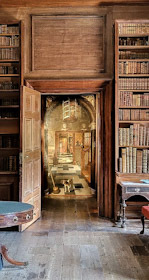
In addition to this trompe l’oeil by Hoogstraten, there is another one placed above a grand staircase at Dyrham House. These two paintings are not the only ones at Dyrham. One of the former owners of the house, William Blathwayt (1649-1717), was a collector of paintings by Dutch masters. Not only did he purchase Dyrham Park, but also, amongst many other achievements, he established the War Office as part of the British Government.



